Devon Heath Service

Heathlands are one of Devon’s most valuable wildlife habitats.
England’s rarest ant species, churring nightjars, Dartford warblers, colourful dragonflies and beetles, lizards and slow worms, and a wasp that builds clay pots to store food for its young: all these amazing animals have evolved to thrive among the heather.
But these special places have not always been well cared for.
Nationwide, around 80% of heathland has been lost since the 19th century. Planted up with conifers, converted to farmland, built on or simply neglected, these losses mean it’s vitally important that our remaining lowland heath sites are protected.
Photo, Jo Damsell
And not only protected. Heathland is a habitat shaped by human activity. For centuries, open areas of wet or dry heath were maintained by small numbers of grazing livestock. When this traditional form of management declined, many heathlands became dominated by gorse and scrub.
Now it’s essential that this habitat is managed to ensure wildlife can continue to thrive on lowland heaths.
Support Devon's heathland wildlife today
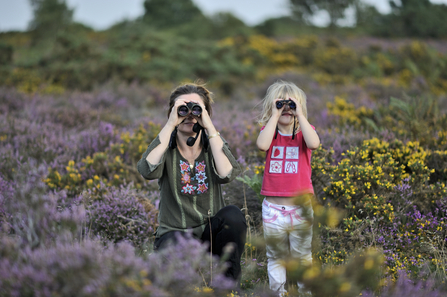
Photo, David Tipling/2020VISION
Devon Wildlife Trust manages some of the most important remaining lowland heathland sites in Devon, including DWT nature reserves like Bystock Pools in east Devon, Ideford Common, near Teignmouth, and sites in the Bovey Basin like Chudleigh Knighton Heath and Bovey Heathfield.
We want to do more to maintain all DWT’s heathland reserves in prime condition for the plants and animals that find a home in lowland heath.
But with recent cost increases in materials from tools to fuel to fencing, we need to raise at least £5,500 from the Devon Heath Service fundraiser by 31 March to carry out essential habitat management on half a dozen heathland reserves this year.
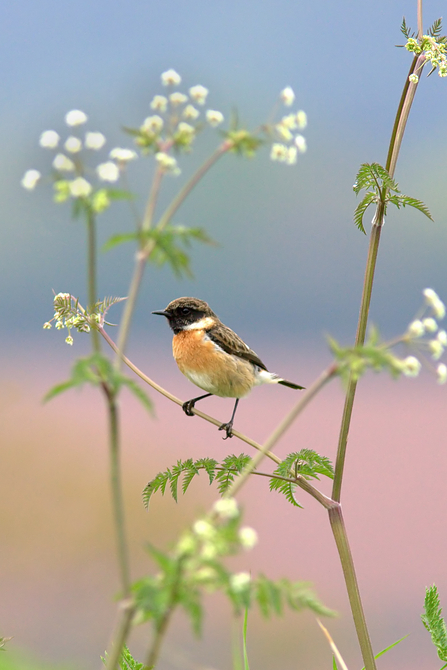
Stonechat (Neil Bygrave)
Without management, heathlands would revert to scrubby woodland. While that habitat would still be a space for some wildlife, we would lose the creatures that have evolved to specialise in lowland heaths.
It's vital that we maintain the ‘heath service’ provided by well-managed nature reserves for the array of wildlife that relies on lowland heath.
Please support the Devon Heath Service fundraiser with a donation before the campaign ends on 31 March - thank you!
Six fantastic species your donation will support
Heath potter wasp
In the tradition of Devon artisans working in clay, the female of this ingenious insect rolls mud from the clay soils of heathland sites into balls. From around 25 of these balls she then sculpts a ‘pot’, attached to a stem of heather or grass, with an entrance into which she lays a single egg.
This solitary wasp then carries caterpillars to each mud-clay pot to ensure her young have enough food during their larval stage. When she has stuffed the pot with provisions, she seals the hole with more mud. Once the wasp grub has eaten its fill, it will emerge from the pot as an adult.
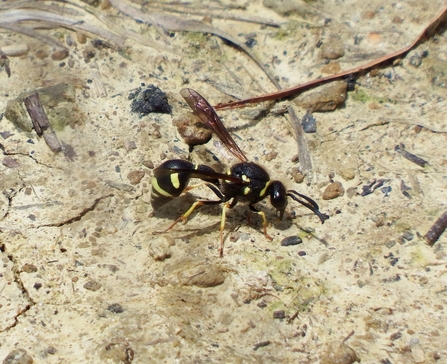
Heath potter wasp collecting clay at Bovey Heathfield (David Cawthraw)
As if each stage of this quarrying and constructing wasn’t amazing enough, if the bare earth is too dry when the wasp needs to create her pots, she will ferry water to her ‘quarry’, to create the mud she needs. DWT’s heathland reserves in the Bovey Basin, such as Bovey Heathfield, are important homes for the heath potter wasp.
By managing the site to leave areas of bare ground, heather, gorse and fresh water in close proximity to each other, DWT can ensure this incredible insect continues to thrive here.
A £30 donation can help the heath potter wasp make pots for many more generations of its young.
Nightjar
At dusk from mid-May onwards you can hear nightjars’ distinctive churring songs at DWT heathland reserves Bystock Pools and Chudleigh Knighton Heath. By day, the birds are camouflaged to near-invisibility on their bare-ground nests.
Nightjar at Chudleigh Knighton Heath. Photo, Chris Root
The good news is that nightjar populations in Devon have increased in recent years thanks to good heathland management providing the right conditions for nesting and a well-stocked larder of moths and beetles to feed breeding adults and their chicks. With your support we can continue to provide nightjars with the nesting and foraging conditions they need.
Your donation will support essential fencing, water supplies and welfare of grazing animals to manage heathlands for nightjars.
Silver-studded blue butterfly
A heathland specialist, the caterpillar of this beautiful butterfly relies on the leaves of bell heather, cross-leaved heath and gorse for food. Adult butterflies then use the heather as a source of nectar. This species has seen large declines in numbers where heathland has been lost across southern England.
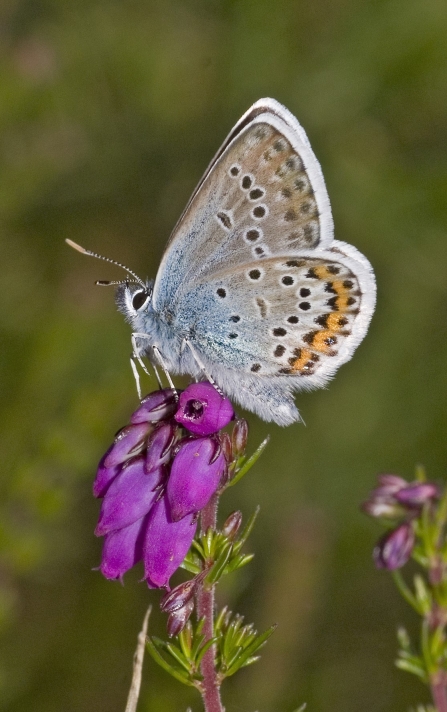
Silver-studded blue. Photo, Chris Root
But as they do not fly significant distances, colonies are very loyal to sites where the lowland heath habitat is well-maintained.
Silver-studded blues thrive at Bystock Pools and Ideford Common, but DWT was also delighted by the first confirmed records of silver-studded blues returning to Bovey Heathfield after years of habitat improvements.
A donation of £40 can help this stunning butterfly continue to thrive on DWT heathland reserves.
Green tiger beetle
In managing heathland sites, it’s important to maintain areas of bare ground. These are used by common lizards and adders to generate energy by basking in the sun. And these bare patches are where you are also likely to see one of the most efficient predators in a lowland heath: the green tiger beetle.
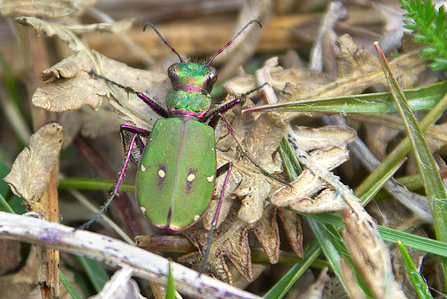
Green tiger beetle (John Bridges)
Making full use of its long legs and big jaws to catch ants and spiders, this vivid green insect is one of the UK’s fastest moving beetles, but they can be spotted at DWT reserves like Ideford Common.
Your donation will help DWT maintain areas of bare ground on heathland reserves to benefit insects and reptiles.
Narrow-headed ant
Forming much smaller colonies than wood ants, with only around 1,000 ants from each nest, DWT has a particular responsibility for the narrow-headed ant. Never common, this ant was recorded at several sites in southern England, but in recent decades the only site in the whole country with a thriving population of narrow-headed ants is DWT’s Chudleigh Knighton Heath nature reserve.
Narrow-headed ants forage for aphid honeydew on plants near their nests. At Chudleigh Knighton Heath they do this especially on birch, so management requires maintaining birch saplings close to nest areas, without trees and scrub creating too much shade that would lead the nest to fail.
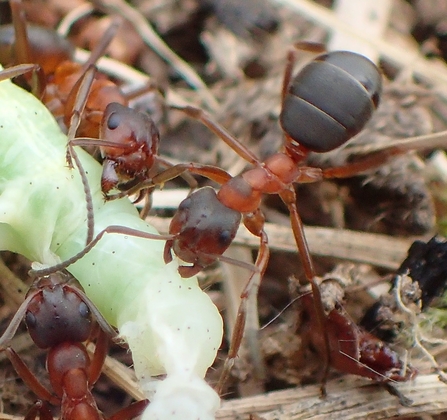
Narrow-headed ant preying on caterpillar at Chudleigh Knighton Heath (John Walters)
In recent years, DWT partnered with invertebrate conservation charity Buglife on a project to translocate narrow-headed ant nests and queens to two nearby DWT heathland sites. So management of habitats around the introduced nests at Teigngrace Meadow is essential to ensure access to food and materials for the ants to maintain their nests, while making sure nests are not shaded out by gorse or scrub.
DWT is committed to providing this ‘heath service’ for the translocated narrow-headed ants for at least the rest of this decade – a £25 donation will help support England’s rarest ant species on two nature reserves.
Dartford warbler
One of our most distinctive heathland birds, Dartford warblers rely on the food supply of abundant invertebrate life found among the heather and gorse. Hunting for spiders and caterpillars among the gorse, they also use these dense shrubs for nesting in spring/summer and for shelter in the winter.
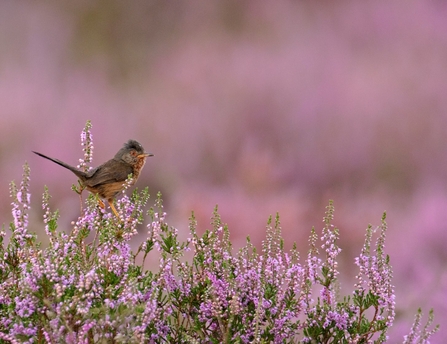
© Chris Gomersall/2020VISION
As a rare British warbler that doesn’t migrate south in autumn, they can fall victim to harsh winter further north, but Devon’s relatively mild climate means the Bovey Basin and East Devon are important strongholds for this magnificent bird.
Dartford warblers can be seen and heard at DWT’s Ideford Common and Bovey Heathfield reserves. Your donation will support heathland management to benefit heathland birds on DWT reserves.
Support Devon's heathland wildlife today
Six heathland reserves where your donation will help wildlife
Bystock Pools
Bystock is one of DWT’s most well-loved nature reserves. Habitat management ensures the site contains a very diverse mosaic of habitats, including woodland, grassland and open water in addition to the lowland heath.
To manage heathland for the most diverse range of wildlife, the aim is to sustain a mix of four growth stages of heather, (known as ‘pioneer’, ‘building’, ‘mature’ and ‘degenerate’). Bystock has a good mix of these growth stages, but the largest areas contain ‘building’ and ‘mature’ heather.
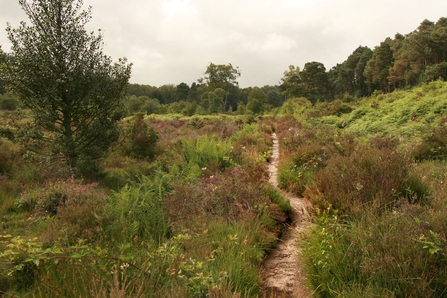
Heathland at Bystock Pools (Simon Williams)
So this year’s main task will be to create more space for the pioneer stage of young heather by managing bracken and scrub. Clearing areas of bracken will also help create areas of bare ground which will benefit reptiles and many invertebrates including ants, and heathland butterflies such as grayling. The bare ground created may also allow areas of lichen heath to develop which will further diversify the heathland habitat there.
Grazing by ponies is an essential part of the management of Bystock. That means fencing has to be maintained around the reserve, something that has increased greatly in cost in recent times; a £50 donation will help continue this vital habitat management.
Venn Ottery
On the opposite side of the East Devon Pebblebed Heaths to Bystock, this is another insect-rich heathland site maintained by grazing animals and scrub clearance.
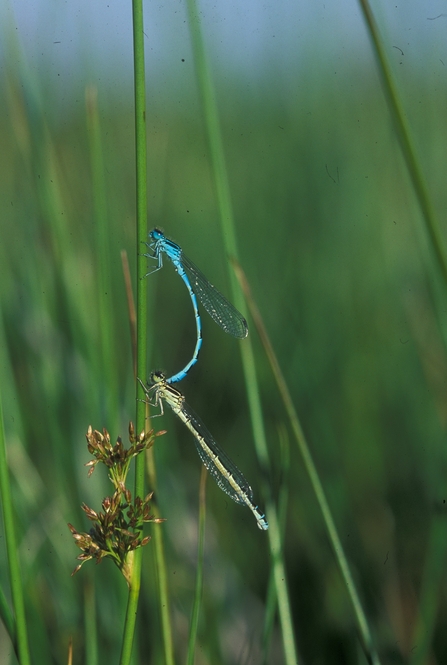
Southern damselflies (Steve Day)
Home to a successful re-introduction of rare and threatened southern damselflies since 2009, the reserve supports 21 species of dragonfly and damselfly in total, along with 40 bird species. Common lizards, slow worms, grass snakes and adders are also found here.
Exmoor ponies carry out much of the management at Venn Ottery, and your donation will allow them to continue their crucial work for wildlife, by supporting maintenance of the fencing that keeps the ponies where wildlife needs their work.
Bovey Heathfield
When DWT took on Bovey Heathfield in 2002, the nature reserve was a wasteland of burned-out cars and fly-tipped rubbish, criss-crossed by muddy trails created by illegal off-road biking. Although designated a Site of Special Scientific Interest it was reputed at that time to be the SSSI in the worst condition in the country.
DWT’s team, including a small army of enthusiastic volunteers, worked for years to repair the damage on the site, re-seeding bare ground with heather, creating ponds for amphibians and dragonflies, maintaining open areas for basking reptiles and attracting local people and community groups to enjoy a thriving nature reserve.
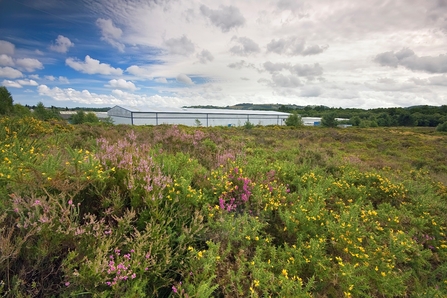
Bovey Heathfield. Photo, David Chamberlain
Once a much wider area of heathland, much of the habitat has been lost to the nearby industrial estate and housing. All the more need for this nature reserve – with its butterflies, other insects and birds that have evolved to thrive on heathlands – to be maintained in the best possible condition by DWT staff and volunteers.
This year, we need to create more patches of bare ground near pioneer heather to benefit the Kugelann’s green clock beetle. Bovey Heathfield is an important site for this insect, which has only been recorded in 15 places in Britain this century.
A £30 donation will help support this beetle and the many other species that thrive in this site that has already recovered from historic ill treatment - and needs our ongoing 'heath service.'
Clayhidon Turbary
One of three near-neighbouring DWT reserves in the Blackdown Hills, Clayhidon contains important areas of heathland that DWT has recovered thanks to management.
By introducing conservation grazing, the Molinia grasses that were smothering the mature heather are now much reduced. Bracken clearance is helping new areas of pioneer heather to grow too.
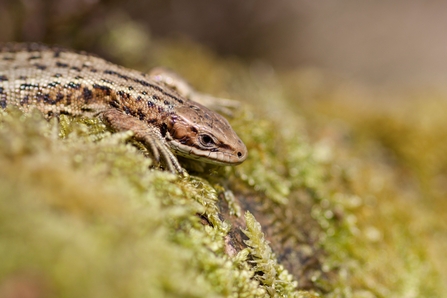
Common lizard (Tom Marshall)
By opening up the areas of scrub at Clayhidon the site will provide more suitable conditions for slow worms and adders and for a wide range of plant life including cotton grass, bog asphodel and insectivorous plants such as pale butterwort.
Your donation can help us create more space for rare plants, insects and reptiles at this nature reserve.
Chudleigh Knighton Heath
The only site in England with a thriving population of narrow-headed ants, this reserve is also important for nightjars, and supports a wide range of dragonflies and damselflies.

Chudleigh Knighton Heath (Simon Williams)
There is a significant amount of scrub clearance required on this reserve this year, not only close to the narrow-headed ant nests but also around one of the ponds where there are records of great crested newt.
A donation of £25 will support removal of conifers and scrub to ensure Chudleigh Knighton Heath’s precious insect life can continue to thrive here.
Ideford Common
DWT’s newest heathland nature reserve is Ideford Common. Since taking on management of this site in 2019, DWT has been clearing encroaching scrub to restore a diverse age range of heather.
Ideford Common nature reserve is near Teignmouth
Birdlife at the site includes stonechat, nightjar and Dartford warbler, while the reserve has important populations of bog bush cricket and silver-studded blue butterfly.
Hand-tools for volunteers and machinery for staff to carry out vital scrub clearance at this reserve are increasingly costly – your donation will support this essential work for wildlife.
Support Devon's heathland wildlife today
Enjoy a guided walk at DWT’s newest heathland reserve
For contributions of £150 and above, DWT can offer a guided tour of Ideford Common, a 40 hectare heathland with a wide range of bird and insect life, and stunning views of the Teign estuary.
If you would like to secure a place on a guided walk here, with Nature Reserves Officer Clare Inglis, just add a note in the 'Add a public message' section of the donation form with the words ‘Ideford Common walk’.
A pledge of £150, or higher, secures two places on a guided walk on weekday in summer 2024 – exact date to be agreed with donors.
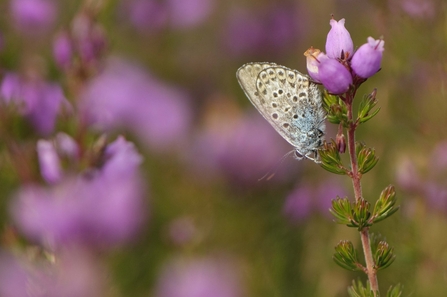
©Chris Gomersall/2020VISION
Please support the Devon Heath Service fundraiser today
With your help, DWT can maintain the ‘heath service’ that ensures a wide range of birds, insects, reptiles and plants can continue to thrive on Devon’s remaining heathlands.
Can you help us reach the £5,500 target by 31 March?
Thank you!
